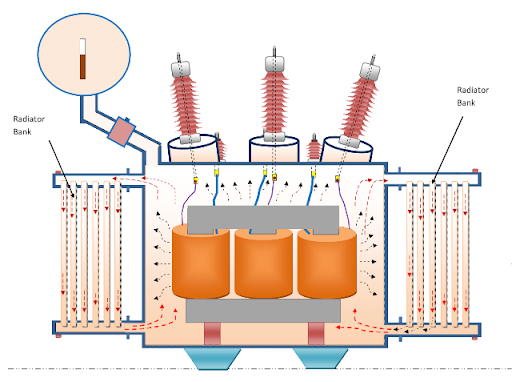The Radiator of Oil - Immersed Transformer
The radiator is an essential type of equipment of oil transformers used to transfer the thermal energy from one medium to another for the purpose of cooling. The radiators are linked to the transformer through the pipeline at the upper and lower side of the transformer which is shown in fig.
Function of Radiator
When heat is generated in the windings and core due to the flow of current through its windings and core losses, The temperature of transformer oil increases. It is known that the rating of any electrical equipment depends upon its allowable temperature rise limit. Therefore, if the temperature rises of the transformer insulating oil are controlled, the capacity or rating of the transformer can be spread up to significant limitations. The radiator of the transformer plays a key role in increasing the loading capacity of an electrical transformer.
The oil-immersed power transformer is generally equipped with a detachable pressed sheet radiator and isolating valves. But in the case of small-sized distribution transformers, the radiators are usually an integral part of the transformer body and projected from the main tank.
The working principle of the radiator
It just increases the surface area for heat dissipation of the oil. As for power transformers, due to shipping restrictions, they are shipped separately and assembled on-site with the main body of the transformer. At the time of shipping, the radiator wings are covered with gasket and plates. The radiator valves on the main tank are also covered by gaskets and plates.
Assembling and Mounting of Transformer Radiator
It is necessary to take special care while removing radiators from crates and during handling and mounting the radiator bank. This is due to any minor damage that can cause oil leakage from the bank as radiator units are made from very thin steel sheets of metal for good to conduct heat well from the oil to the air. After removing from crates, it is required to clean these radiators externally. These radiators must be cleaned internally by flashing with transformer insulating oil.
It is required to assemble the radiator units one by one that means, fitting and fixing of one unit must be completed in all respect before the next unit will be assembled. The assembling should be initiated from one side and finished on the other side. Before assembling the unit, blanketing plates from the top and bottom radiator valves must be removed. During the removal of blanketing plates; if there is a damaged gasket surface, it should be replaced by the new gasket.
Then lift the radiator unit vertically and bring it nearer to the respective main tank valves. Now the blanketing plates of the main tank valves are removed. the radiator flange is fitted on the respective valve of the main tank by nuts, bolts, plain, and spring washers. all the other radiator units are assembled in the same manner.
After all the units are assembled, insulating oil will be filled. This should also be completed one unit by one unit. For that, first, the bottom valve is opened and the exhaust plug on the top of the radiator is also slowly removed. Oil from the main tank will enter the transformer radiator. The air begins to escape from the exhaust plug until the unit is filled with transformer insulation oil. The oil filling of the unit is completed when the oil drains from the unscrewed air drain plug. Then, the air release plug is tightened and the top radiator valve opens.
Operation of Transformer Radiator
Under the loaded condition, the volume of warm oil increases and enters the upper portion of the main tank. Then this oil comes into the radiator through the top valve and cools down by dissipating heat through the thin radiator wall. This cold oil returns to the main tank through the bottom radiator valve. This cycle is redone continuously till the load is linked to the transformer.
The forced air from means of fans accelerates further dissipation of heat in the transformer radiator. These fans are fitted either nearby the bank or on the radiator bank itself but all the fans must be faced towards the radiator. Sometimes, the cooling rate of the convectional circulation of oil is not enough. At that time an oil pump may be used with the aim of speeding up oil circulation.

